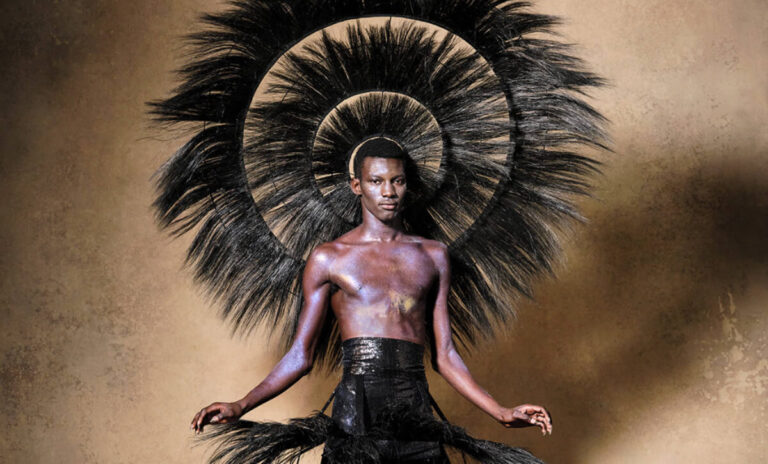Inside ‘Fashioning Masculinities’, the V&A exhibition deconstructing society’s approach to menswear
A new exhibition at London’s Victoria and Albert Museum (V&A) is assessing the role of fashion throughout history in constructing and deconstructing our attitudes towards masculinity. “At a moment of unprecedented creativity in men’s fashion and reflection on gender,” explain the curators, “this exhibition explores how designers, tailors and artists—and their clients and sitters—have constructed and performed masculinity, and unpicked it at the seams.”
Fashioning Masculinities. In just two words, the title does a lot: not just fashion but fashioning, suggesting the construction and performativity of gender. And masculinities, plural, is essential—there’s not a single masculinity on display here. A similar exhibition held at the Barbican in 2020, Masculinities: Liberation through Photography, explored masculinity via the mediums of photography and film, while the V&A show focuses on fashion.
Specifically, the show explores three different themes: ‘Undressed’ on underwear, extravagant regalia in ‘Overdressed’ and the history of suits and tailoring in ‘Redressed’. Throughout the exhibition, there’s a mix of artworks from the museum’s collection, fashion photography, and couture outfits, elegantly hung on bespoke mannequins. Artists featured include Auguste Rodin, David Hockney and Anthony Patrick Manieri, who have been celebrating representations of the male form in various media throughout the centuries.
This is the V&A’s first major show dedicated to menswear. “We’ve always had menswear on display in our galleries,” co-curator Rosalind McKever told GQ, “which is partly where the idea for the show began.” Rather than a comprehensive or linear history, the curators wanted to ask specific questions and probe certain themes. “We wanted to ask, ‘what is a suit?’ Is it a two-piece? A top and trousers? What are the elements that make a suit a suit?” McKever explained.
Musicians play a central role throughout the exhibition. Think Bowie, Prince or The Rolling Stones, who constantly challenges conventions of masculinity with their onstage personae, including fashion. Harry Styles features prominently, including his infamous November 2020 Vogue cover, lensed by Tyler Mitchell, and his starring role in Gucci’s Pre-Fall 2019 campaign—Gucci is a corporate partner for the exhibition and Alessandro Michele’s show notes from AW20 appear at the exhibition’s start. Outfits worn by Billy Porter, Marlene Dietrich and David Bowie are also featured in the fashion display.
Harris Reed, a recent Central Saint Martins (CSM) graduate and rising star on both sides of the Atlantic, is a notable voice—including a self-portrait in their Fluid Romanticism 001 collection and an outfit featured on one of the posters for the show. Reed is best known for gender-fluid romanticism, engaging with the traditions of tailoring with a decidedly queer edge. They have dressed Styles for the Vogue cover mentioned previously and Iman for the 2021 Met Gala. Reed also presented three “fashion performances” at the museum’s Raphael Court, with music from Years & Years. Frontman Olly Alexander had previously collaborated with Reed on an outfit for last year’s BRIT Awards.
“Being included in an exhibition like this is quite surreal,” Reed told CNN. “I remember going to a museum as a small kid and not seeing any representation of myself whatsoever. So it’s quite an emotional thing coming here today and really seeing everything together.”
Fashioning Masculinities: The Art of Menswear is a complex and fascinating show, which feels like just the tip of the iceberg: the objects and outfits included have been carefully selected without being overwhelming. Such eclectic survey exhibitions on fashion are rarely seen in the UK—perhaps more common at the Metropolitan Museum of Art’s Costume Institute. And while the V&A’s opening party wasn’t quite on the level of the Met Gala, a number of stars were in attendance, including train fanatic and TikTok sensation Francis Bourgeois, It’s A Sin co-stars Nathaniel Curtis and Alexander, and Bimini Bon Boulash.
Bimini’s runway look from the season two finale of RuPaul’s Drag Race UK, where they finished as runner-up, was one of the final outfits on display—a contemporary take on bridal wear, made with their regular collaborator Ella Lynch. Drag, both queens and kings alike, has seen some of the most provocative and experimental fashion designs in recent years, freed from the limitations of catwalk presentations. Bimini is a perfect example, especially within the UK scene, who, in collaboration with Lynch, has created various outfits that engage with the histories of both fashion and queer culture.
“It feels like the beginning of something rather than the end,” McKever added. “We want people to feel emboldened and for designers and other museum curators to think of menswear as a primary focus, not just a secondary category behind womenswear in both a museum show and the wider world of fashion.”





